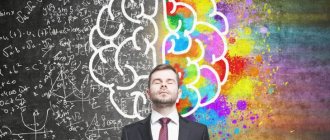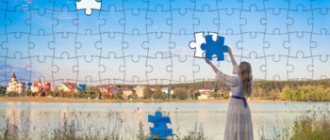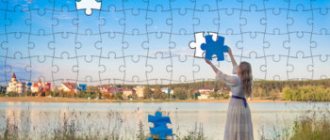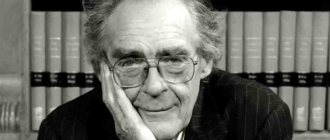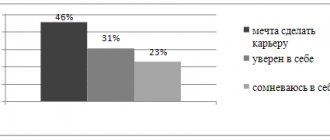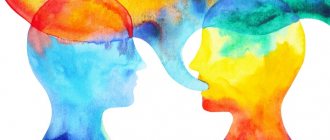Basic Concepts
Imagination is not only a tool of a creative person.
It is valuable for a representative of any profession, because it allows you to think creatively and go beyond standard ideas.
Fantasy makes it possible not only to create from scratch, but also to imagine images and diagrams without errors in the process of reading scientific and fiction literature, to solve problems directly related to the use of visual-figurative thinking, to plan future activities, and to memorize information more effectively.
Active (one that works voluntarily) imagination is divided into:
- Recreating. This is a person’s ability to recreate images, models, diagrams in his head based on a description, which is usually given either orally or in writing.
For example, the reconstructive imagination is actively involved while reading fiction books: the reader imagines in detail the characters, setting, actions, intonation, and so on. - Creative. This is the ability to create original images, concepts, and diagrams. Of course, any creative person relies on already existing concepts, rules, ideas, creating something of his own, but at the same time, the product of his imagination will differ to one degree or another from everything that existed before.
Techniques or, in other words, operations of the imagination are directly related to creative imagination .
Creative imagination largely works on the basis of the “analysis-synthesis” scheme: first, the images that exist in a person’s memory are analyzed, their characteristics and relationships are determined; then a process of splitting occurs with the aim of constructing something new from the resulting material.
Operations of imagination are the methods by which fantasy carries out the process of analysis and synthesis.
The main operations of imagination are agglutination, hyperbolization, addition, typification, emphasis, transfer, analogy.
Emotions and feelings, properties and types of emotions.
When a person perceives objects and phenomena of the surrounding world, he always relates to them in some way and experiences certain feelings. Some events cause him joy, others - indignation, he likes some things, others don’t, he loves some people, hates others, and is indifferent to others.
Feelings are a person’s internal attitudes to what is happening in his life, what he knows or does, to other people and to himself, experienced in various forms.
Emotions are physical states and processes that arise as a result of the action of significant phenomena and situations on an individual and manifest themselves in the form of direct experiences.
Emotions and feelings for a person are an indicator of how the process of satisfying needs occurs. A person compares information about what is required to satisfy a need with what he has at the time of its occurrence. If the likelihood of satisfying a need is high, positive feelings appear. Negative emotions are generated by the inability to satisfy a need or by a drop in its probability compared to the forecast that the subject gave earlier.
Functions of emotions and feelings:
1. Reflective (allows you to determine the usefulness or harmfulness of an event).
2. Incentive (the emotional experience contains an image of an object and a biased attitude towards it, which encourages a person to act).
3. Reinforcing (significant events are imprinted in memory faster and for a long time).
4. Switching (discovered when there is a competition of motives, as a result of which a dominant need is determined).
5. Adaptive (thanks to emotions, the significance of certain conditions for meeting current needs is established, so the body can effectively adapt to certain environmental conditions).
6. Communicative (facial expressions and pantomimes allow a person to convey his experiences to other people). Thanks to this function, a person can influence other people.
Techniques
What are the techniques of imagination?
Agglutination
Agglutination is an operation in which elements related to different phenomena or objects are combined to create something new.
This technique can often be found in mythology, fairy tales and legends of different peoples of the world, in works of art written in the genres of fantasy and science fiction.
Examples of agglutination:
- Sea maiden. Traditionally, sea maidens are attractive girls with a fish-like tail instead of legs, existing in European mythology. In Russian they are usually called mermaids, despite the fact that classic mermaids, taken from Slavic mythology, do not have a tail.
- Sphinx. This mythical creature became quite famous, and many peoples depicted it in different ways. The most famous image of the Sphinx is a creature with the body of a lion and a human head.
- Centaur. A famous mythical creature - half man, half horse - that has migrated from myths to many famous fantasy universes, for example, to the Harry Potter universe.
- A hut on chicken legs. An ominous attribute in many Russian folk tales: a hut standing on strong legs (two or four) reminiscent of chickens, often able to move with their help and behaving like a relatively intelligent creature.
- Animals from the popular animated series Avatar: The Last Airbender and Avatar: The Legend of Korra. In the fantasy universe of these animated series, there are a huge number of animals created using the “agglutination” technique: mole badgers, lion turtles, rabbits (rabbit and kangaroo), turtle crabs, platypus bears and many others.
- Hippogriff from the Harry Potter series of books and films. According to the description in the books, the hippogriff is a large animal that is a mixture of a horse (torso, tail and hind limbs) and an eagle (head, wings and forelimbs). May have different colors.
From Latin the word “agglutination” is translated as “sticking.” This term is used not only in psychology, but also in biology and linguistics, and has different meanings.
Hyperbolization
Hyperbolization - a phenomenon or creature is deliberately depicted as larger or smaller so that its image works in the context of the story being told, creates certain emotions, and looks more or less significant compared to others.
The number of elements that are part of the object can also be increased or decreased.
This technique is also often found in mythology, fairy tales , science fiction or fantasy settings.
Examples:
- Thumbelina. The tiny size of the girl from Andersen's fairy tale made it possible to realize the plot that was presented (interaction with small animals and insects on equal terms) and to emphasize her vulnerability.
- A dragon with several heads. In many stories and fairy tales, dragons have more than one head: usually there are three, or seven, or twelve. Since dragons are traditionally represented in fiction as negative characters that must be defeated, the number of heads emphasizes the danger posed by them and makes it difficult for the protagonist to fight.
- Many-armed Indian gods. Many Indian deities are depicted with many hands. Their hands symbolize their power and ability to do many things at the same time. In some cases, philosophical connotations are attributed to additional hands.
Other examples include other creatures, such as the god Janus, who has two faces, or the Cyclops, who has only one eye.
Addition
Addition - some object (often a material object) is given characteristics that are not the norm for it in everyday life.
Examples of the use of such an operation can also be easily found in many fantasy works of art.
Examples:
- Invisible hat. Makes the one who wears it completely invisible. The invisibility cloak from the Harry Potter series of books has a similar skill.
- Self-assembled tablecloth. A special tablecloth that can materialize an unlimited amount of delicious and varied food, you just need to spread it and say the magic words.
- Magic wand. In earlier works of art, such wands simply fulfilled the owner's wishes when waved.
For example, in the Harry Potter series, the magic wand became a tool that releases the wizard's power. The staves of magicians, which appear in many fantasy universes, have similar skills.
Other examples : seven-league boots, flying carpet.
Typing
Typification is a technique in which the characteristics of similar objects, phenomena, people belonging to the same group are collected and used to create a unique image that is a reflection of a certain reality.
Typification is common in many works of classical literature: some famous characters represent a combination of such traits that reflect the problems and essence of individual groups of the population, becoming a mirror of their century, era.
Examples:
- Faust;
- Eugene Onegin;
- Mitrofanushka from the play “The Minor” by D. I. Fonvizin;
- Landowners from the work “Dead Souls” by Gogol (Korobochka, Manilov, Nozdryov).
Accenting
Emphasis is a technique in which individual characteristics of a character or other creature are emphasized, often excessively, necessary for ridicule or greater expressiveness.
Examples:
- Caricatures. This type of art is aimed at ridiculing various phenomena, ideas, personalities, historical events, and vices of society, often in a rude manner, using black humor and stereotypes. Cartoonists focus on those features that they seek to ridicule. For example, a chatterbox might have a long tongue.
- Cartoons. This type of art has a direct connection with caricature, but does not ridicule anything, it only focuses on the external characteristics of a person or animal. Typically, a cartoon is a recognizable portrait in a humorous style, implausibly exaggerating individual features of the object. The cartoons bring a smile and a good-natured laugh to those who look at them.
Transfer
Transfer (or displacement ) is a technique in which a creature or other object is placed in non-standard conditions in which it should not have been placed.
As an example, we can cite characters who in the fan community are called “accidents” : these are either unusual, fairy-tale heroes who find themselves in our world and adapt to life in it, or ordinary people who, by chance, find themselves in a fantastic or fantasy universe.
Examples of famous people:
- Old Man Hottabych. The story of an ancient genie who found himself in Soviet realities and met the boy Volka is known to most of those who were born in the nineties and earlier.
- Children from the Narnia series created by Clive Lewis. A fantasy classic that sits alongside the works of Tolkien.
It also makes sense to remember Alice who found herself in Wonderland, Dorothy (who became Ellie in Volkov’s adaptation) and many others.
The very idea of zoos can be attributed to displacement : animals find themselves in non-standard conditions.
Analogy
Analogy - an original image is created on the basis of something that is already present in reality and has the necessary abilities.
Examples:
- Airplanes and other devices designed for flight were created based on observations of birds and animals that glide with the help of wings (flying squirrels).
- An analogy for radars and locators is the mouth and ears of bats, with the help of which they navigate.
Expression of emotions and feelings.
Often the words “emotions” and “feelings” are used as synonyms. But emotions are situational. Emotions are the immediate, temporary experience of a feeling. For example, an emotion is not the feeling of love for music itself, but the state of admiration that a person experiences at the moment while listening to a concert.
Emotions and feelings can be positive or negative in quality. But sometimes negative emotions can have a positive connotation (anger at a bad deed). And sometimes it is possible to experience opposite emotions (“I’m sad and easy,” Pushkin). This phenomenon is called ambivalence (duality) of feelings (love and hatred with jealousy).
Emotions and feelings can also be viewed from the point of view of whether they cause an active or passive state. If emotions motivate actions, statements, or increase the tension of forces, they are called sthenic (from the Greek “stenos” - strength). For example, a person is ready to “move mountains.” Joy, anger, hatred are sthenic emotions. If the experience of emotion is characterized by passivity and relaxes a person, then they speak of asthenic emotions (“asthenos” - weakness).
As they say, “your legs give way.” Sadness, melancholy, despondency are asthenic emotions. But for some people the same emotions can be experienced as sthenic, for others as asthenic. For example, the emotion of fear can cause a helpless state in one person, and a violent reaction in another.
According to the form of flow, the whole variety of emotions and feelings can be divided into emotions (in the narrow sense of the word), affects, moods, frustration, stressful conditions, higher feelings, passions, hobbies. These forms of experiencing emotions and feelings form the emotional sphere of the individual.
Emotions (in the narrow sense of the word) are the direct experience of a feeling.
The following “fundamental emotions” (according to K. Izard) or basic emotional states are distinguished:
1. Interest is a positive emotional state that contributes to the development of skills and knowledge.
2. Joy is a positive emotional state associated with the opportunity to satisfy an urgent need, the likelihood of which was low until this moment.
3. Surprise - does not have a clearly defined positive or negative sign, occurs suddenly, inhibits all previous emotions and directs attention to the object that caused it. It can turn into interest.
4. Suffering is a negative emotional state associated with reliable or apparent information about the impossibility of satisfying the most important needs of life, which until this moment seemed more or less probable. They are asthenic in nature.
5. Anger is a negative emotional state caused by a sudden serious obstacle to the satisfaction of an extremely important need. Has a sthenic character.
6. Disgust is a negative emotional state caused by objects (people, objects, circumstances), contact with which (physical interaction, communication, etc.) comes into sharp conflict with the moral or aesthetic principles of the subject.
7. Contempt is a negative emotional state that arises in interpersonal relationships and is generated by a mismatch between the life positions of the subject and the life positions or behavior of the object itself.
8. Fear is a negative emotional state that manifests itself when the subject receives information about possible damage to his well-being in life, about a real or imagined danger that threatens him. It has both sthenic and asthenic character.
9. Shame is a negative emotional state, expressed in the awareness of the inconsistency of one’s own thoughts and actions not only with the expectations of others, but also with one’s own ideas about appropriate behavior.
Affect – (from Latin аffectuctus – emotional excitement) a strong and short-term emotional state associated with a change in life circumstances that are important to a person. It is characterized by a change in consciousness, a violation of control over actions, and a loss of self-control. It quickly takes hold of a person and proceeds violently. The effects are short-lived, because cause a huge expenditure of effort. If an ordinary emotion is emotional excitement, then affect is a storm, an explosion.
A person loses control over himself, committing reckless actions, and then he may regret it and remember it as if in a dream. After an affective outburst, weakness and loss of strength sets in. Any emotion can develop into affect: joy into delight, anger into anger, fear into horror, suffering into despair. We can say that affect is bad or good depending on what emotion the person is experiencing. A person can control affect and restrain its onset in the early stages.
Mood is a general emotional state that colors all human behavior for a long time (joyful, sad, serious, frivolous, cheerful, lethargic). Usually the mood is not consciously realized by the person, but sometimes it has significant intensity and leaves an imprint on both mental activity and work productivity (everything goes wrong).
Mood is an individual’s unconscious assessment of how favorable circumstances are for him. Sources of mood: satisfaction or not with the course of life, affairs at work, in the family; health status, weather, etc. Moods also vary in duration. It depends on: age (in children it changes quickly), character, temperament, willpower, etc. Mood influences behavior and stimulates or inhibits activity.
Stress - (from the English stress - pressure, tension) occurs in unusually difficult situations and is experienced with great internal tension. In terms of its psychological characteristics it is close to affect, and in terms of its duration - to mood. May be sthenic or asthenic in nature (example with the exam). Occurs when there is danger, great physical and mental stress, etc. Stress can be physiological and mental.
Psychological stress, in turn, is informational (a person cannot cope with a task, does not have time to quickly make the right decision with high responsibility) and emotional (threat, danger, resentment). Different people experience stress differently (“lion stress”, “rabbit stress”). According to their orientation, they distinguish stress (positive orientation, ensures the mobilization of body systems, for example, in case of danger) and distress (negative orientation, is destructive, leads to exhaustion of the body).
Close in its manifestations to stress is the state of frustration.
Frustration is (from Latin frustratio - deception, frustration, destruction of plans) a human state caused by objectively insurmountable (or subjectively perceived) difficulties that arise on the way to achieving a goal. Frustration is accompanied by a whole range of negative emotions that can disorganize consciousness and activity.
In a state of frustration, a person may exhibit anger, depression, external and internal aggression, frustration, motor agitation (purposeless and disordered movements), and apathy. The level of frustration depends on the strength and intensity of the influencing factor, the person’s condition, the type of temperament and the forms of response he has developed to life’s difficulties. A particularly common source of frustration is negative social evaluation.
